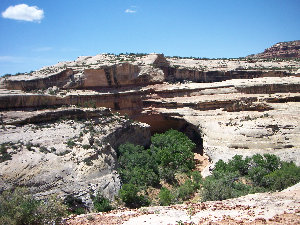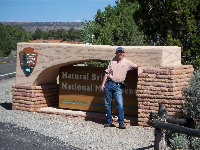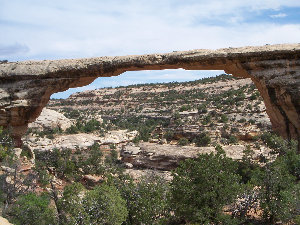Natural Bridges National Park
Natural Bridges sits high on Cedar Mesa, about 6,500 feet above sea level. Natural bridges are essentially arches that form in the path of rivers & streams through water erosion rather than weather erosion. In 1883 prospector Cass Hite wandered up White Canyon in search of gold. Instead, he found three magnificent bridges that the water had carved in the stone. In 1904 the National Geographic published pictures of the bridges & in 1908 President Theodore Roosevelt established Natural Bridges National Monument, creating Utah's first National Park System area. Trails go from the road to the bridge which involve some climbing but you will find the hikes well worth the effort.
Click on a Picture to Enlarge

Considered the youngest of the three bridges, Kachina Bridge is a massive bridge with a span of 204 ft & a height of 114 ft. There is a pile of boulders under the far side of the bridge that resulted from a rock fall in 1992 when 4,000 tons of rock broke off the bridge.


With a span of 180 ft and a height of 106 ft, Owachomo Bridge affords the most picturesque view of the three bridges. It's delicate form indicates that it has eroded more quickly than the other bridges. Bears Ears Buttes, a prominant feature in the area, are visible from Owachomo Bridge.

With a span of 268 ft & a height of 220 ft, Sipapu Bridge is the second largest natural bridge in the world. In Hopi mythology, a "sipapu" is a gateway through which souls may pass into the spirit world.

The Bears Ears Buttes have been the source of native oral traditions. One Navajo story tells of Changing-Bear-Maiden who was very beautiful but had no interest in men. The trickster, Coyote persuaded her to marry him & Changing-Bear-Maiden began to transform into a mischieveous bear. Her brothers, believing the only way to save her was to change her into another form, killed her by cutting off her ears & throwing them away. They became the buttes seen today.
Me at the entrance to Natural Bridges.




